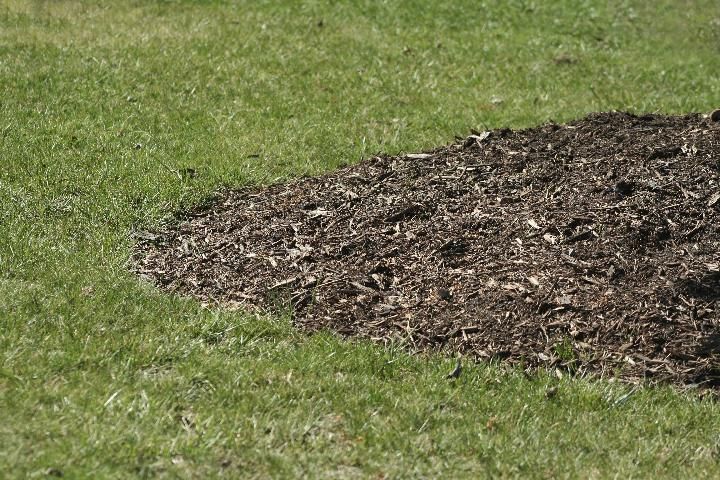
Credit: Jim Mills/iStock/Thinkstock, © Jim Mills
Mulches are an increasingly important part of the Florida urban landscape. Mulches are known to buffer soil temperature, prevent water loss from evaporation, and reduce erosion. Weed control either by inhibiting weed germination or suppressing weed growth is another benefit of mulches. These advantages and the increasing interest in mulching have resulted in a wide array of mulches available for the gardener and landscaper.
Many questions emerge about the additional benefits of these various mulches. One common question is which mulch settles the soonest and needs to be replaced? Settling or subsidence is the packing down and/or thinning of mulches with time. Mulch subsidence is a concern for landscapers because as mulch settles its benefits such as weed control diminish, and it needs to be replenished or replaced. This article is one of a series of fact sheets, which compare six common Florida landscape mulches (Duryea et al. 1999; Duryea et al. 1999).
The Study
In this study six landscape mulches were compared:
- Cypress (bark and wood from Taxodium distichum [L.] Rich. and Taxodium distichum var. nutans [Ait.] Sweet)
- Eucalyptus (bark and wood from Eucalyptus grandis W. Hill ex Maiden)
- Melaleuca (bark and wood from Melaleuca quinquenervia [Cav.] S.T. Blake)
- Pine-bark (bark with some wood from Pinus elliottii [Engelm.] and Pinus taeda [L.])
- Pine-straw (needles from Pinus elliottii Engelm.])
- Gainesville Regional Utility (GRU) mulch containing utility-prunings (leaves, wood, and bark) from oaks (Quercus laurifolia Michx., Quercus rubra [L.], and Quercus virginiana Mill.) and cherry (Prunus serotina Ehrh.), with a small amount of cedar (Juniperus silicicola [Small] Bailey) and southern pines (Pinus spp.).
All mulches (except the GRU utility-pruning mulch) were purchased at garden stores in Gainesville, Florida, either by the bag or bale (pine-straw).
To compare the settling of the six mulches we installed plastic rings with 9 cm (3.5 in) deep mulch in a plowed open field at the Austin Cary Memorial Forest near Gainesville. Every 3 months in the first year and again after 2 years, the depth of the mulches was measured.
Settling of the Mulch
All the mulches settled some in the first year with the pine-straw and the utility mulch settling the most (Figure 2). After two years the pine-straw was almost completely gone with an average depth of 1 cm. The utility and eucalyptus mulches were next with about 5 out of the 9 cm remaining. Pinebark and cypress had the same amount (6 cm) and melaleuca was still the deepest with almost 7 of the original 9 cm left.

Other studies have had similar results with mulch settling. In a study that compared 15 organic mulches, leaf mulches (grass, oak, and pine needles) had the greatest subsidence along with two-yard waste mulches (Stinson et al. 1990). In another study, cypress settled the least followed by eucalyptus, melaleuca, and pine-straw (Brown 1996). Mulches that have leaves will settle more than woody mulches.
Conclusions
As mulch settles or becomes thinner, its benefits are diminished. Weeds will be able to germinate and grow without impediment. Evaporation from the exposed soil will increase causing soils to dry out sooner. Exposure to rain and wind may increase erosion. For these reasons as mulch settles, it needs to be replenished or replaced.
In this study pine-straw mulch settled the most, decreasing to half its depth in 1 year and a negligible amount of mulch after 2 years (Table 1). Melaleuca was superior to the other mulches, although pine-bark and the cypress still had 6 of the 9 cm left—enough mulch to provide all of the benefits. This study showed that after applying mulch at a depth of 9 cm, four of the six mulches maintained a useful depth for 2 years.
References
Brown, S. 1996. "Response of Hibiscus to organic mulches." Proc. Fla. Hort. Soc. 109:30–33.
Duryea, M. L., R. J. English, and L. A. Hermansen. 1999. "A comparison of landscape mulches". J. Arboric. 25:88–97.
Duryea, M. L., J. B. Huffman, R. J. English, and W. Osbrink. 1999. "Will subterranean termites consume landscape mulches?" J. Arboric. 25:143–150.
Stinson, J. M., G. H. Brinen, D. B. McConnell, and R. J. Black. "Evaluation of landscape mulches". Proc. Fla. Hort. Soc. 103:372–377.